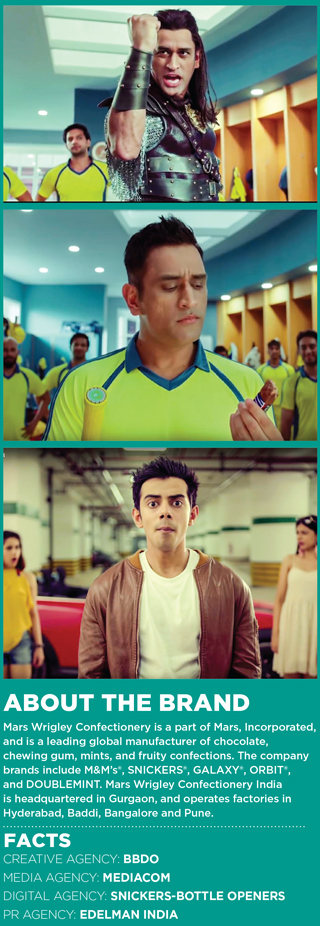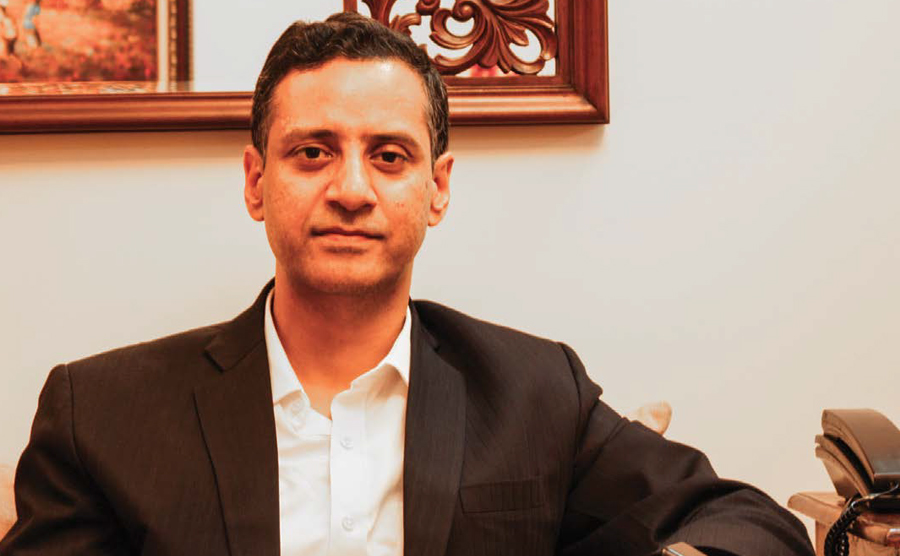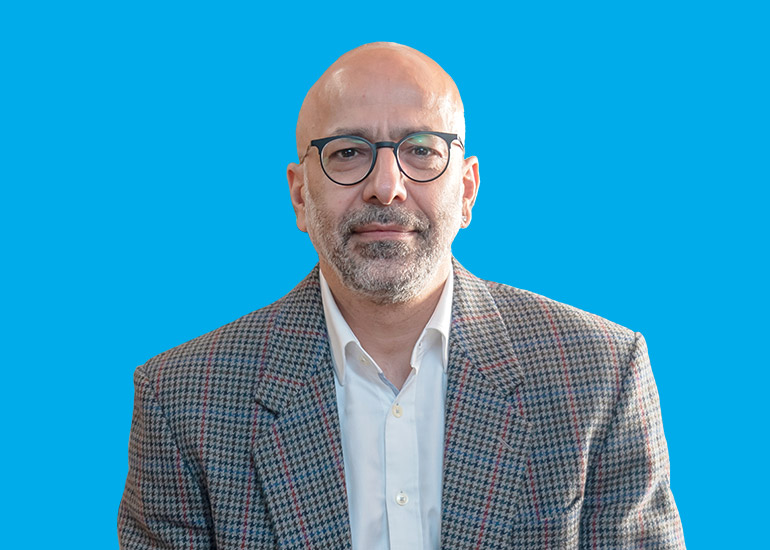Q] Snickers’ first campaign was quite bold and set the brand rolling in India. Since then you have had quite a few extensions of the positioning ‘hunger acche accho ko badal deta hai’. Can you take us through Snickers’ brand journey from its launch to where it stands today?
Snickers is a global brand and we have the same positioning across all markets. The campaign is stretchable because it’s based on a universal insight that has multiple executions. Most markets have made it relevant to local context and India is no different. We launched the campaign with Rekha and received great acceptance from consumers. It was a bold and creative risk but it went off very well. People started understanding the concept of ‘You are not you when you are hungry’. We have come quite far in terms of not just the campaign, but the entire environment around it.
If you look at the product journey, we customized Snickers specifically for the Indian market, making it vegetarian and offering it at a competitive price point. We launched a Rs. 10 product which gave us a huge opportunity to reach our consumers in traditional trade. We’ve also made changes in the recipe, making it a little robust. And all this has been well complemented by our brand campaign.
Post that campaign, we did another one with Sonam Kapoor which was an extension of the same creative idea, but with different execution. And through the campaign with Dhoni, we have taken it a notch higher, gaining us a wider audience in terms of cricketers who are relevant across different states, as compared to Hindi and Bollywoodrelevant geographies. Secondly, M S Dhoni is a legend who is revered, with a character that is very well established. So on the creative side, the campaign could leverage his strength, character and acceptance across different age groups and demographics, and the results have been fantastic for us.
Now we are in a position to do bold campaigns like ‘hunger bars’ that we released last year on Twitter, which was only possible because the brand is really well established among consumers; not just by way of branding but also in terms of the colours, taste and packaging. That development on brand journey gave us the confidence that we can show off our brand name with another trait.
Q] You also have other brands like Galaxy, Mars, Bounty and Twix. Does this actually cannibalize your share of Snickers?
We haven’t seen that happening yet. I think the category is quite big. Our brands are fairly well differentiated and very distinctive. Secondly, from a distribution perspective, Snickers is the most widely distributed brand for us. The other brands provide more choices to consumers, specifically focusing on the modern trade and top six grocer towns. So, we haven’t really seen cannibalization happening.
 Q] Snickers is so far the biggest brand in your portfolio. Do you plan to invest in any other brand in a similar way?
Q] Snickers is so far the biggest brand in your portfolio. Do you plan to invest in any other brand in a similar way?
Over the last couple of years, we have expanded our portfolio in India. There has been a conscious investment on behalf of the company in India - whether it’s manufacturing facilities or work that we do with communities, and that reflects on our brands as well. We launched M&M in India last year, which is one of the largest brands in the world in the chocolate segment. On the confectionery side, we launched Doublemint, one and half years ago. So we are investing in the entire portfolio, and in the future we would also look at expanding and bringing in more brands.
Q] M&M is in the small bite-sized and shareable snack category. We saw a digital campaign of yellow and red. How have you supported that campaign post the launch in the last one year?
M&M for us was a brand where we actually went Digital right from the word go. We launched it on Amazon and forged partnerships with many of these key players. From the Digital perspective, it’s a constant connect. It cannot be switch-on and switch-off. So we have that ongoing conversation with the consumer. We have also held in-store activations where we create a story on M&M, for Valentine’s Day or the summer season, for example. We keep creating these small occasions where there is a nice reason for us to connect with customers.
Q] Cadbury Gems has the biggest share in the category where M&M plays. How are you competing against them?
We don’t compare ourselves with Gems. M&M is the number one brand in the world in chocolates. We conducted consumer research to validate whether customers see the quality of M&M as what we believe it is. Based on the results of that research, we have decided where we want to play in pricing and distribution. Thus, we are not really playing in the same segment as Cadbury Gems. We are trying to build the category of pop-up pure chocolate in bitesize. Essentially, it’s about how to build occasions where consumers can connect with their friends and families and share the good moments with them, with our products. And that’s what M&M stands for.
Q] In case of Doublemint, you launched a campaign #StartSomethingFresh, which was again on the lines of your global campaign. How have you taken this brand forward, especially given the fact that it is part of a very low involvement category?
Doublemint is more about consumers seeking a solution for fresh breath. Our brand stands for creating those occasions where consumers can make meaningful connections. That was the insight that was leveraged when we created the launch campaign. To our surprise, even though the category is not that high involvement, when we looked at the response that we got for the campaign, it was amazing. We had a video which was about 3.30 minutes long, and more than 50% of viewers watched it in full. We got a similar response on our product as well. Consumers loved it and the benefit of freshness that it provides. We will continue with the same campaign for Doublemint, given the success of the same.
Q] What’s has been the key consumer insight in the Indian market that drives your marketing strategy?
I think the key insight of Indian consumers is that they want value for money and a quality product. Therefore all our marketing strategies focus on creating products which are just the right fit for India, in terms of best quality of chocolate experience, the price pack architecture that gives the right distribution and the product size impression and pricing where consumers seek value for money. Once you have got this strategy right, then it’s about communicating the story of the brand to the consumer in the best way possible.
Snickers is a global brand and we have the same positioning across all markets. The campaign is stretchable because it’s based on a universal insight that has multiple executions. Most markets have made it relevant to local context and India is no different. We launched the campaign with Rekha and received great acceptance from consumers. It was a bold and creative risk but it went off very well. People started understanding the concept of ‘You are not you when you are hungry’. We have come quite far in terms of not just the campaign, but the entire environment around it.
If you look at the product journey, we customized Snickers specifically for the Indian market, making it vegetarian and offering it at a competitive price point. We launched a Rs. 10 product which gave us a huge opportunity to reach our consumers in traditional trade. We’ve also made changes in the recipe, making it a little robust. And all this has been well complemented by our brand campaign.
Post that campaign, we did another one with Sonam Kapoor which was an extension of the same creative idea, but with different execution. And through the campaign with Dhoni, we have taken it a notch higher, gaining us a wider audience in terms of cricketers who are relevant across different states, as compared to Hindi and Bollywoodrelevant geographies. Secondly, M S Dhoni is a legend who is revered, with a character that is very well established. So on the creative side, the campaign could leverage his strength, character and acceptance across different age groups and demographics, and the results have been fantastic for us.
Now we are in a position to do bold campaigns like ‘hunger bars’ that we released last year on Twitter, which was only possible because the brand is really well established among consumers; not just by way of branding but also in terms of the colours, taste and packaging. That development on brand journey gave us the confidence that we can show off our brand name with another trait.
Q] You also have other brands like Galaxy, Mars, Bounty and Twix. Does this actually cannibalize your share of Snickers?
We haven’t seen that happening yet. I think the category is quite big. Our brands are fairly well differentiated and very distinctive. Secondly, from a distribution perspective, Snickers is the most widely distributed brand for us. The other brands provide more choices to consumers, specifically focusing on the modern trade and top six grocer towns. So, we haven’t really seen cannibalization happening.
 Q] Snickers is so far the biggest brand in your portfolio. Do you plan to invest in any other brand in a similar way?
Q] Snickers is so far the biggest brand in your portfolio. Do you plan to invest in any other brand in a similar way? Over the last couple of years, we have expanded our portfolio in India. There has been a conscious investment on behalf of the company in India - whether it’s manufacturing facilities or work that we do with communities, and that reflects on our brands as well. We launched M&M in India last year, which is one of the largest brands in the world in the chocolate segment. On the confectionery side, we launched Doublemint, one and half years ago. So we are investing in the entire portfolio, and in the future we would also look at expanding and bringing in more brands.
Q] M&M is in the small bite-sized and shareable snack category. We saw a digital campaign of yellow and red. How have you supported that campaign post the launch in the last one year?
M&M for us was a brand where we actually went Digital right from the word go. We launched it on Amazon and forged partnerships with many of these key players. From the Digital perspective, it’s a constant connect. It cannot be switch-on and switch-off. So we have that ongoing conversation with the consumer. We have also held in-store activations where we create a story on M&M, for Valentine’s Day or the summer season, for example. We keep creating these small occasions where there is a nice reason for us to connect with customers.
Q] Cadbury Gems has the biggest share in the category where M&M plays. How are you competing against them?
We don’t compare ourselves with Gems. M&M is the number one brand in the world in chocolates. We conducted consumer research to validate whether customers see the quality of M&M as what we believe it is. Based on the results of that research, we have decided where we want to play in pricing and distribution. Thus, we are not really playing in the same segment as Cadbury Gems. We are trying to build the category of pop-up pure chocolate in bitesize. Essentially, it’s about how to build occasions where consumers can connect with their friends and families and share the good moments with them, with our products. And that’s what M&M stands for.
Q] In case of Doublemint, you launched a campaign #StartSomethingFresh, which was again on the lines of your global campaign. How have you taken this brand forward, especially given the fact that it is part of a very low involvement category?
Doublemint is more about consumers seeking a solution for fresh breath. Our brand stands for creating those occasions where consumers can make meaningful connections. That was the insight that was leveraged when we created the launch campaign. To our surprise, even though the category is not that high involvement, when we looked at the response that we got for the campaign, it was amazing. We had a video which was about 3.30 minutes long, and more than 50% of viewers watched it in full. We got a similar response on our product as well. Consumers loved it and the benefit of freshness that it provides. We will continue with the same campaign for Doublemint, given the success of the same.
Q] What’s has been the key consumer insight in the Indian market that drives your marketing strategy?
I think the key insight of Indian consumers is that they want value for money and a quality product. Therefore all our marketing strategies focus on creating products which are just the right fit for India, in terms of best quality of chocolate experience, the price pack architecture that gives the right distribution and the product size impression and pricing where consumers seek value for money. Once you have got this strategy right, then it’s about communicating the story of the brand to the consumer in the best way possible.
























